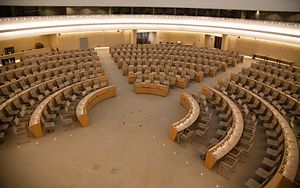On September 24, the U.S.-led UN Human Rights Council (HRC) resolution on Sri Lanka was tabled. This would be the fourth HRC resolution passed on the island nation since 2012.
The Sri Lankan government has praised the resolution and it appears that the original idea of passing it by consensus will go ahead as planned.
The resolution calls for wide-ranging reforms and a domestic accountability mechanism with international involvement. Some commentators have stated that what the resolution demands constitutes a hybrid court or hybrid mechanism. Regardless of one’s interpretation, it remains unclear how much international involvement will actually take place and falls short of some people’s demands (especially from ethnic Tamils) for a purely international mechanism – a wish that remains politically infeasible at this time.
Sri Lanka would need to provide an oral update during the HRC’s thirty-second session and a “comprehensive report” during the HRC’s thirty-fourth session (in March 2017).
Though at times the language in the resolution is vague, the document contains a multitude of useful recommendations related to governance, human rights, accountability and reconciliation. It’s somewhat surprising, however, that the resolution does not address the country’s sustained militarization in a more clear and comprehensive way.
In an email interview with The Diplomat, Sudarshana Gunawardana, executive director of Rights Now Collective for Democracy (a Colombo-based human rights organization), stated that he was pleased to see the Sri Lankan government work with other countries on a consensus resolution. “I am particularly happy to see that foreign judges will be involved in the judicial mechanism,” he noted.
In spite of Colombo’s backing of the resolution, it’s likely to receive significant criticism within Sri Lanka. Some commentators, especially ethnic Sinhalese, have already voiced (predictable) complaints that what it calls for constitutes excessive international intervention and violates the country’s sovereignty. Many Tamils (both in Sri Lanka and abroad) may argue that the resolution does not go far enough, and that even more international involvement is needed. That said, the Tamil National Alliance (TNA), the country’s principal Tamil political grouping, was quick to endorse the resolution. The Sri Lanka Muslim Congress (SLMC) has also welcomed it. Additionally, the Global Tamil Forum (GTF), a major Tamil diaspora organization based in London, has “cautiously” welcomed the resolution.
Even though negotiations at the Geneva-based HRC are not over, it’s unlikely that the text will be alternated significantly in the coming days. It will be interesting to see what, if any, additional modifications are made to the existing draft. Gunawardana mentioned that “getting a consensus resolution passed would be a huge leap forward for Sri Lanka after years of (international) isolation. What matters most is how feasible it will be to implement this in Sri Lanka.”
This has been a frantic month for Sri Lanka-related diplomacy. Assuming the resolution is eventually passed (a highly likely scenario), attention would turn towards matching words with action and the implementation of its prescriptions.
The recent advocacy and diplomatic maneuvering that has led to this moment has been very important. Nevertheless, Sri Lanka’s transition from a post-war society to a post-conflict one will ultimately come down to the implementation of needed reforms and serious, sustained political will. With the passage of another HRC resolution on the horizon, the current government’s commitment to accountability, genuine reconciliation and deeper change remains an open question.































